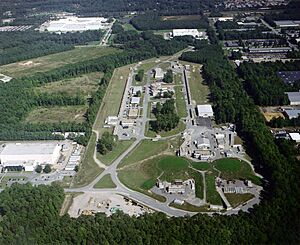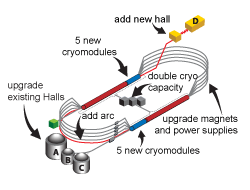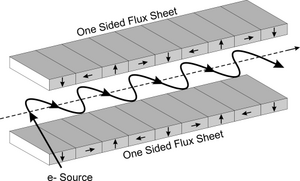Thomas Jefferson National Accelerator Facility facts for kids
 |
|
| Motto | “Exploring the nature of matter.” |
|---|---|
| Established | 1984 |
| Research type | Nuclear physics |
| Budget | US$72 million (2004) |
| Director | Hugh E. Montgomery |
| Staff | 675 |
| Location | Newport News, Virginia |
| Campus | 214 acres (87 ha) |
|
Operating agency
|
Jefferson Science Associates, LLC |
| Website | www.jlab.org |
The Thomas Jefferson National Accelerator Facility (often called Jefferson Lab or JLab) is a special science lab in Newport News, Virginia. It's one of the national labs in the United States.
JLab was started in 1984. Over 675 people work there, and more than 2,000 scientists from all over the world have used its tools for their research. The main goal of JLab is to explore the tiny building blocks of matter. They also work with companies to use their advanced technology and help with education.
The lab is currently making its main machine, called CEBAF, even more powerful. They are upgrading it to go from 6 GeV to 12 GeV. This means adding stronger magnets and a new experimental hall. The upgrade was completed in 2013, and full science operations began in 2015.
Contents
Exploring the Tiny World with the Accelerator
JLab's main research tool is the CEBAF accelerator. Think of it like a super-fast race track for tiny particles called electrons. It has a special electron source that shoots out these particles.
The track itself is shaped like a race-track oval. It has two long, straight parts, each about 7/8 of a mile (1400 meters) long. These are called linear accelerators. At the ends, there are curved sections with strong magnets that bend the electron beam around.
What's cool is that the electrons can go around this track up to five times! Each time they go through the straight parts, they get more energy. Their energy can reach up to 6 GeV (which is a lot of energy for such tiny particles!). It's like having a 7.8-mile-long accelerator, but folded up to fit in a smaller space.
How the Accelerator Works
Unlike most particle accelerators that send out pulses of electrons, JLab's CEBAF sends out a continuous stream. This helps scientists get more detailed information.
JLab uses a special technology called superconducting RF (SRF). This means they cool special materials, like niobium, to super cold temperatures (about -452.5°F or 4 K) using liquid helium. When it's this cold, the material has no electrical resistance. This makes it super efficient at giving energy to the electrons. JLab has the world's largest liquid helium refrigerator to do this!
The accelerator is built about 25 feet (8 meters) underground. Its walls are 2 feet thick to keep everything safe.
Experimental Halls
The electron beam ends up in three special rooms called experimental halls: Hall A, Hall B, and Hall C. Each hall has unique equipment called a spectrometer. These tools record what happens when the electron beam hits a target.
By studying these "collisions," physicists can learn about the inside of an atomic nucleus. They want to understand how the even tinier particles called quarks, which make up protons and neutrons, interact with each other.
Collecting Data from Collisions
When an electron from the beam hits a nucleus in the target, it's called an "interaction" or "event." This causes other tiny particles to scatter into the hall. The detectors in each hall track these particles. They turn what they see into electrical signals. These signals are then changed into digital information by special electronics.
This digital data is collected and stored. Later, scientists can look at this data to figure out what happened during the collision. The whole system that collects and stores this data is called a data acquisition system.
The 12 GeV Upgrade
JLab has added a new experimental hall, Hall D. They also doubled the energy of the electron beam to 12 GeV. This upgrade helps scientists explore even deeper into the atomic nucleus.
The Free-Electron Laser
JLab also has a very powerful free-electron laser. It's one of the strongest in the world! The United States Navy helps fund this research. They are interested in using such powerful lasers for things like shooting down missiles. Because of this military research, the lab is usually closed to the public. However, they do have an open house every two years where people can visit.
The JLab free-electron laser uses a clever trick called an "energy recovery LINAC." Here's how it works:
- Electrons go into a linear accelerator.
- These fast-moving electrons then pass through a special device called a wiggler. This wiggler makes them produce a very bright laser light.
- Instead of just stopping, the electrons are then guided back to the start of the accelerator.
- As they go back, they give most of their energy to a new group of electrons. This means the lab can reuse the electrons and their energy. This makes the laser use less electricity to run.
JLab was the first to use this energy recovery method to create ultraviolet light. Other labs, like Cornell University, are now trying to build similar systems to make X-rays.
CODA: The Data Collection System
JLab's experiments are complex, and they need a good way to collect all the information. So, a group of scientists created a special software system called CODA (which stands for CEBAF Online Data Acquisition system).
CODA is a set of computer tools and recommended hardware. It helps build the systems that collect data from the nuclear physics experiments. In these experiments, detectors can create a huge amount of measurements, or "data channels."
The electronics that turn signals into digital data are often on large circuit boards. These boards fit into a "crate" that gives them power and keeps them cool. In the CODA system, each crate has a special "ReadOut Controller" (ROC) board. This ROC board sets up the other boards, reads the data from them, and organizes it for scientists to analyze later.
- Thomas Jefferson National Accelerator Facility, official site




